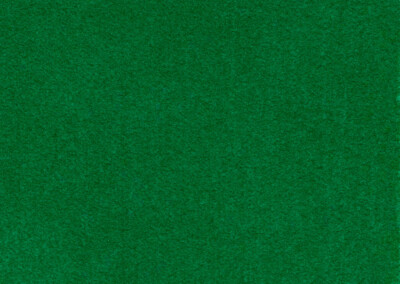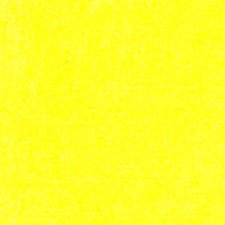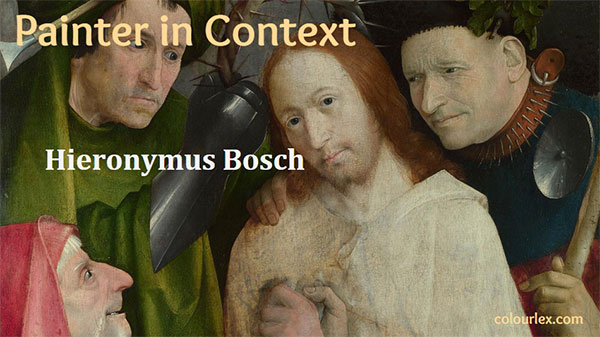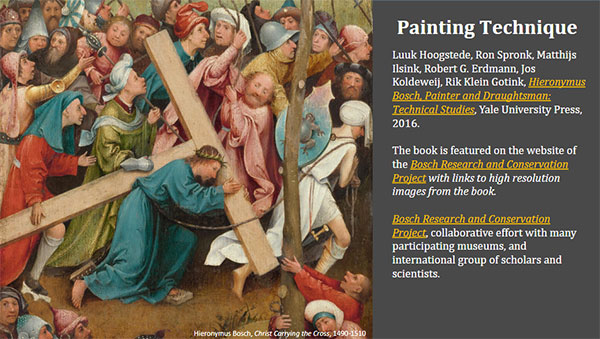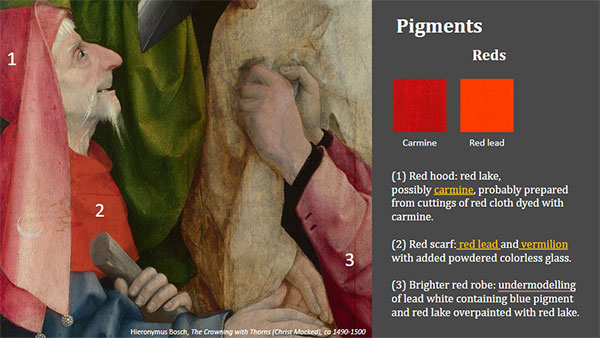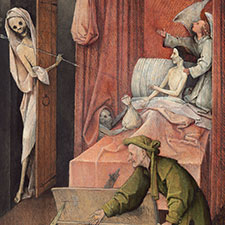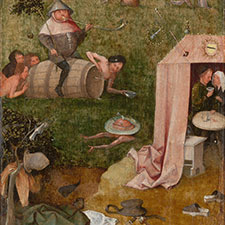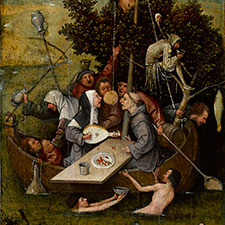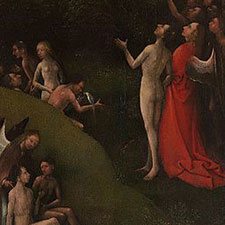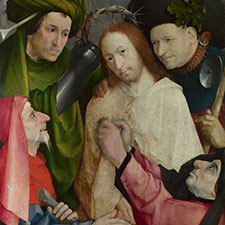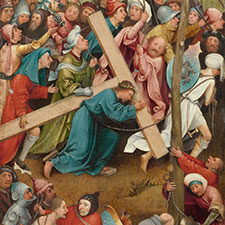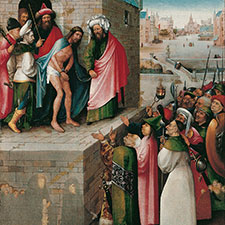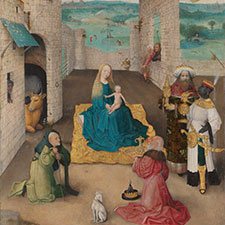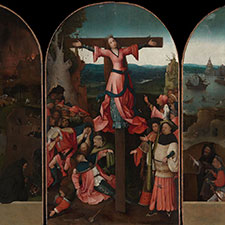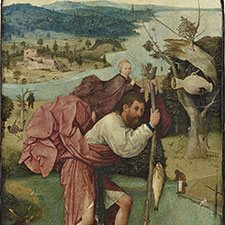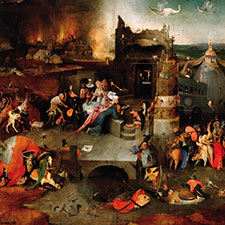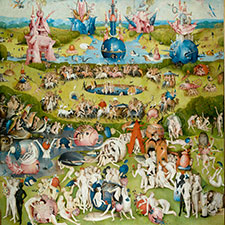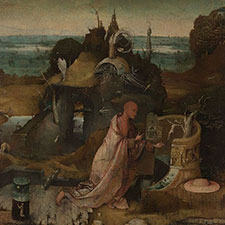Hieronymus Bosch, Death and the Miser
ca 1500-1510Paintings sorted by Historical period | Painter | Subject matter | Pigments used
Overview
The Death and the Miser’ originally formed a part of ‘The Wayfarer Triptych’. It is not known when and in what circumstances the original triptych was dismantled. The other parts of the triptych were “The Wayfarer“, “The Ship of Fools” and its fragment “Gluttony and Lust”. The central panel was lost.
The painting was thoroughly investigated by The Bosch Research and Conservation Project. The results of this investigation were published in a magnificent book referenced in the section “Recommended Books” below. An extensive interactive online feature at the website of the project complements the book and shows all the images from the book in high resolution. The pigment analysis reveals a limited palette consisting of the usual pigments employed in the Renaissance period, such as lead-tin yellow, vermilion, red lake, and lead white.
Date: ca 1500-10
Medium: Oil
Support: Oak
Size: 93 x 31 cm
Art period: Renaissance
National Gallery of Art, Washington
Inventory nr: 1952.5.33
Painting at the website of the BOSCH PROJECT
“Oppositions of good and evil occur throughout the painting. A lantern containing the fire of Hell, carried by the demon atop the bed canopy, balances the cross which emits a single ray of divine light. The figure in the middle ground, perhaps representing the miser earlier in his life, is shown as hypocritical; with one hand he puts coins into the strongbox where they are collected by a rat-faced demon, and with the other he fingers a rosary, attempting to serve God and Mammon at the same time. A demon emerging from underneath the chest holds up a paper sealed with red wax — perhaps a letter of indulgence or a document that refers to the miser’s mercenary activities.”
Quote from the webpage of the painting at the National Gallery of Art Washington
Pigments
Pigment Analysis
This pigment analysis is based on the work of the scientists at The Bosch Research and Conservation Project (1). The scientists employed x-ray radiography (XRR), infrared photography (IRP) and infrared reflectography (IRR) to gain insights into the inner layers of the painting and to identify the pigments.

1 Bed canopy: lead white underpainting covered by a red lake.
2 Fire in the lantern: lead white mixed with red, followed by lead-tin yellow, vermilion, and a purplish glaze.
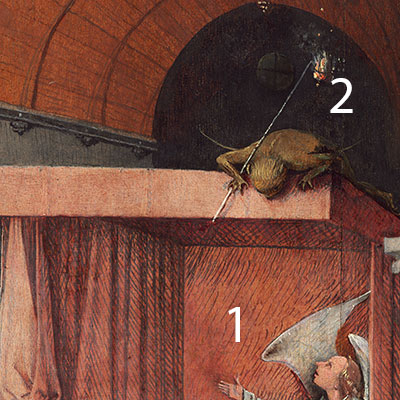
3 Arched window: lead white with black lines and blue dabs indicating stained glass.

4 Miser’s green robe: a mixture of copper green (malachite?) and lead-tin yellow overpainted with deep copper green glaze.
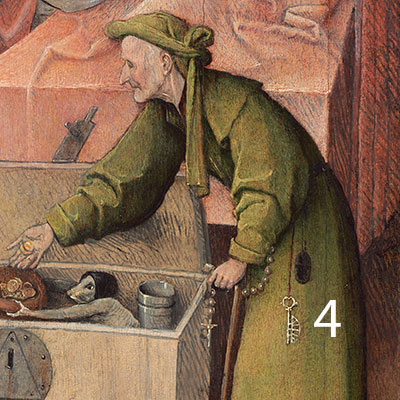
5 The longish object in the chest: lead-tin yellow followed by reddish-brown and black paints.
6 Coins in the chest: brown mixed with red, followed by lead-tin yellow.
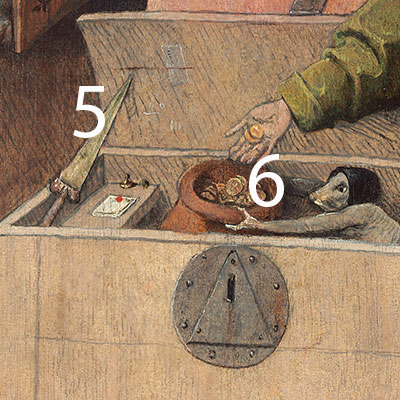
References
(1) Luuk Hoogstede, Ron Spronk, Matthijs Ilsink, Robert G. Erdmann, Jos Koldeweij, Rik Klein Gotink, Hieronymus Bosch, Painter and Draughtsman: Technical Studies, Yale University Press, 2016, pp. 276 – 283.
Pigments Used in This Painting
Resources
See the collection of online and offline resources such as books, articles, videos, and websites on Hieronymus Bosch in the section ‘Resources on Painters‘
PowerPoint Presentations
Painter in Context: Hieronymus Bosch
A richly illustrated presentation on the painting technique and pigments employed by Hieronymus Bosch specially crafted for Art Education. (Number of Slides = 20)
- Each presentation starts with the basic resources on the painter such as his biography, main catalogs of his paintings, and a bibliography.
- Next, you find slides describing the painting technique of the artist and the pigments he usually employed in his work.
- The majority of the slides show examples of paintings containing the specific pigments.
Slides showing the basic resources on the life and works of the Northern Renaissance painter Hieronymus Bosch.
The painting technique and all pigments employed by Bosch are shown in the next slides.
The majority of the slides show important examples of paintings where Bosch employed specific pigments. The slides are organized according to the color of the pigments.
Videos
Video: 'Death and the Miser' by The National Gallery of Art
Video: 'Death and the Miser' by Brian Sottosanti
Publications and Websites
Publications
(1) Matthijs Ilsink, Jos Koldeweij, Hieronymus Bosch: Painter and Draughtsman – Catalogue raisonné, Yale University Press, New Haven and London 2016, pp 316-335.
The above book is also available online in pdf format in two parts: part I and part II.
(2) Luuk Hoogstede, Ron Spronk, Matthijs Ilsink, Robert G. Erdmann, Jos Koldeweij, Rik Klein Gotink, Hieronymus Bosch, Painter and Draughtsman: Technical Studies, Yale University Press, 2016, pp. 290 – 295.
(3) Morganstern, Anne M. “The Pawns in Bosch’s Death and the Miser.” Studies in the History of Art 12 (1982): 33-41.
(4) Vinken Pierre and Lucy Schlüter. “The Foreground of Bosch’s Death and the Miser.” Oud Holland 114, no. 2/4 (2000): 69-78.
(5) Metzger, Catherine A. “Death and the Miser: Alterations and Implications.” In Jérôme Bosch et son entorage, et autres études, edited by Hélène Verougstraete and Roger van Schoute. Le dessin sous-jacent et la technologie dans la peinture, Colloque 14, Bruges and Rotterdam, 13-15 september 2001. Leuven, 2003: 39-43.
(6) Colenbrander, Herman T. “Avare vixisti: Death and the Miser by Hieronymous Bosch–Drawings, Underdrawings, Painting, and Meaning.” In Jérôme Bosch et son entorage, et autres études, edited by Hélène Verougstraete et Roger van Schoute. Le dessin sous-jacent et la technologie dans la peinture, Colloque 14, Bruges and Rotterdam, 13-15 september 2001. Leuven, 2003: 22-32.
(7) Vinken, Pierre and Lucy Schlüter. “The Foreground of Bosch’s Death and the Miser” and “Pieter Brugel’s Birdnester and Man’s Encounter with Death.” Icons and Enigmas: Investigations in Art. Edited by Christopher Paparella and Heleen Vinken. Amsterdam, 2014: 77-93, 114-115, fig. 1, 7.
Websites
Website of the Bosch Project
Website of the Bosch Research and Conservation Project



